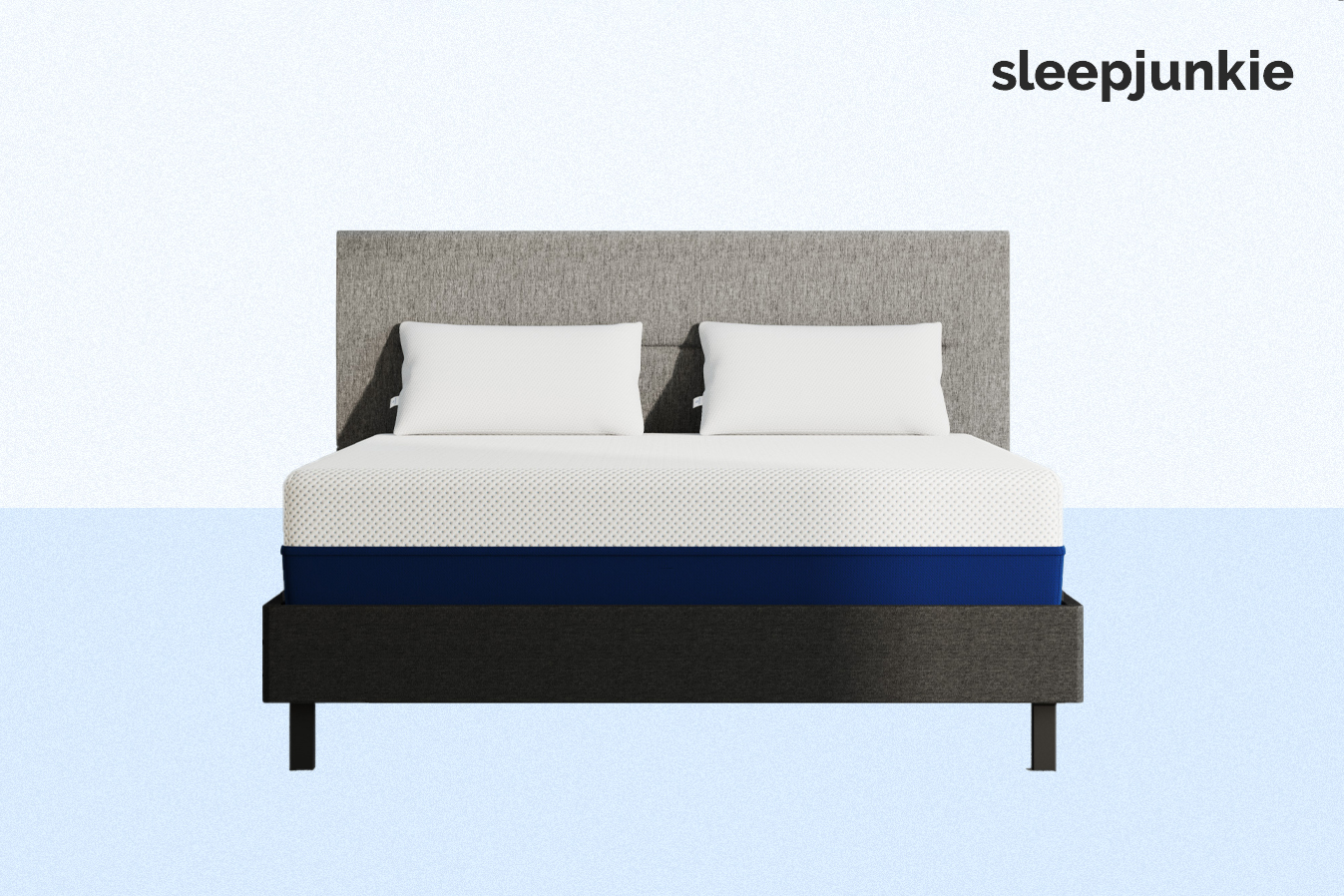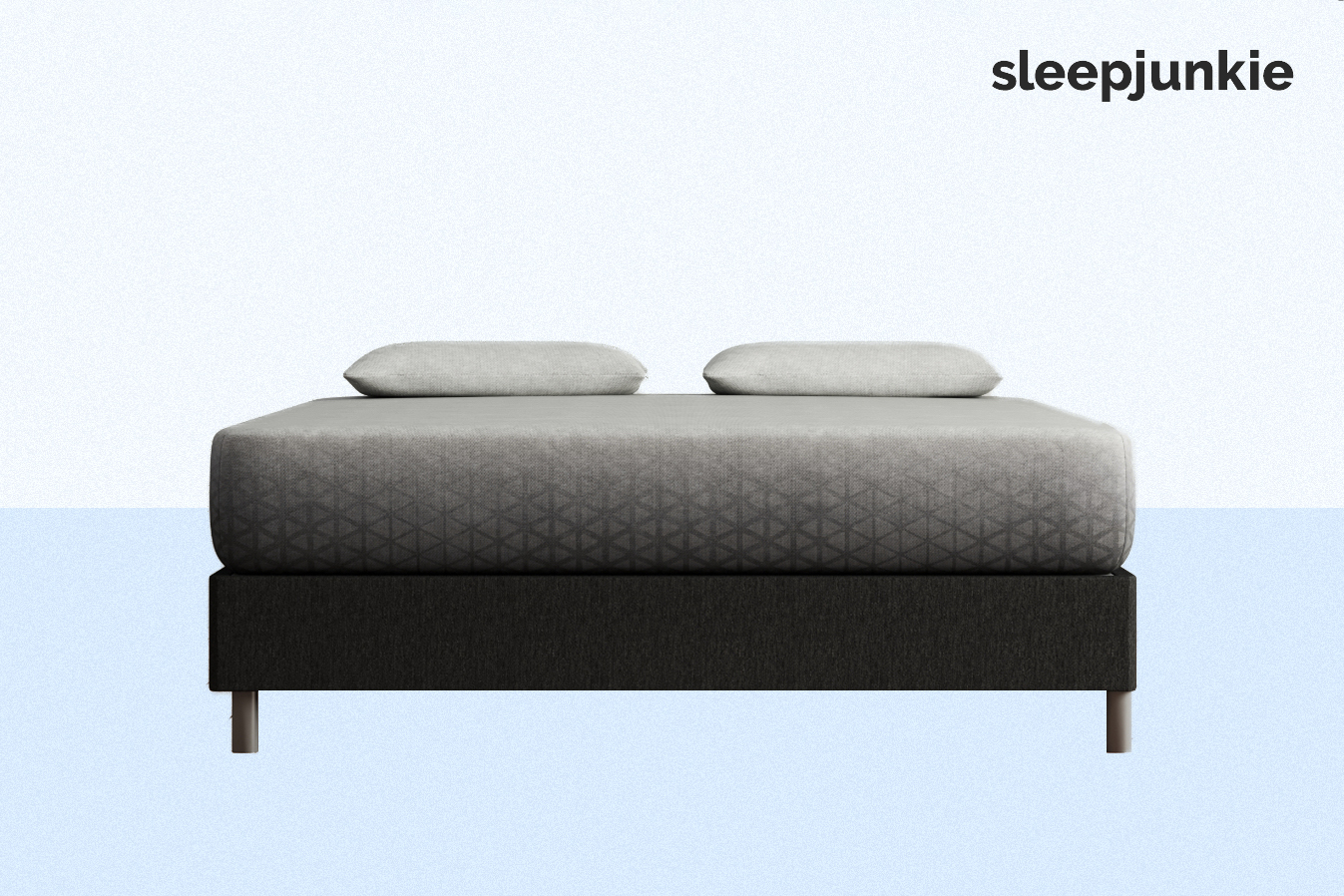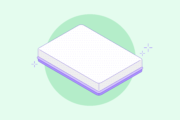
Hybrid Mattress Buying Guide

- Hybrid mattresses provide an exceptional sleep experience by combining the comfort of latex or memory foam with the bounce of an innerspring mattress.
- Their unique design addresses the need for both pressure relief and adaptability, making them a top choice for various types of sleepers.
- Understanding the composition of hybrid layers, including the comfort, transition, and support layers, is essential for making an informed decision.
When it comes to comfort and support, hybrid mattresses are tough to beat. They combine the comfort of a latex or memory foam mattress with the bounce of an innerspring mattress for an amazing sleep experience.
The problem is, there are so many hybrids on the market at the moment it can be hard to sift through all of them. Do you need a latex or memory foam hybrid? What firmness level is right for you? And what on earth is coil count anyway?
Below, we’ll answer these and more of your burning questions about hybrid beds so you can make an informed decision about your new mattress. We’ll also give our top recommendations for a hybrid mattress.
The Amerisleep AS3 Hybrid is one of the best hybrid mattresses out there. From its balance of cushioning and support to the great prices, there’s nothing not to love about the AS3 Hybrid.
The AS3 Hybrid is 12 inches thick and has a medium feel suited for side and combo sleepers. Couples will also love this bed when you need to compromise on a firmness with your partner. Inside the AS3 Hybrid is Bio-Pur® memory foam, Affinity transition foam, pocketed coils, and a foam base.
Bio-Pur® is a plant-based memory foam. Standard memory foam is made from petroleum, which isn’t very durable, traps heat, and causes you to feel “stuck” in bed. Worst of all, it off-gases—that factory-like, “new car” smell. Bio-Pur® is made from castor oil, resulting in a more breathable, durable, and fresh-scented memory foam.
The Affinity layer features HIVE® technology, a zoned support system. The layer is split into five ergonomic zones around your head, shoulders, back, hips, and legs. This way, your body parts are more closely cushioned or supported.
The springs inside the AS3 Hybrid are wrapped in thin fabric to reduce wear and motion transfer. The coils on either edge of the bed are reinforced to ensure there’s proper edge support. Beneath the coil layer is foam base which helps prolong your mattress’s lifespan.
Amerisleep mattresses are made in the USA and CertiPUR-US® certified. They come with free shipping and returns, a 100-night sleep trial, and a 20-year warranty.
AMERISLEEP AS3 HYBRID
- Breathable and responsive plant-based memory foam
- Five zones of targeted support and pressure relief
- Durable mattress base increases mattress's expected lifespan
The Zoma Hybrid is another great hybrid mattresses, particularly for hot sleepers and chronic pain sufferers. Originally built for athletes, the Zoma Hybrid facilitates deeper sleep while enhancing muscle relaxation and recovery. It’s 12 inches thick and has a medium-soft feel, which is a great choice for side sleeping.
Zoma uses their proprietary AirCloth fabric for the hybrid’s cover. It’s breathable and moisture-wicking so the nights of waking up in your own sweat will be long over with.
At the top of the Zoma Hybrid is gel foam. The gel infusions in the foam draw heat away from your body, making it easier to get comfortable and sleep undisturbed.
The Zoma Hybrid’s transition layer is made from Reactiv™ foam. While the gel memory foam is already rather responsive, the Reactiv™ foam adds extra flexibility and adaptiveness to the bed. This way, you don’t feel “stuck” in your own bed.
Finally comes the pocketed coil layer. The Zoma Hybrid contains hundreds of coils that isolate motion and support a healthy spine. There are extra-firm coils on the sides of the bed to prevent saggy, unsupportive edges.
At the base of the Zoma Hybrid is a thin base foam. The foam gives a surface for the coils to bounce on, absorbing shock and minimizing wear throughout the bed.
With the Zoma Hybrid, you get a 100-night trial and a 10-year warranty. Plus, it ships for free and, in case you don’t love the bed, returns are free too!
ZOMA HYBRID
- Gel memory foam moves heat away from the body
- Buoyant transition foam minimizes spinal misalignment
- Supportive base foam provides structural intregrity
Layers of a Hybrid Mattress
Hybrid mattresses come in tons of different configurations, but they all must have two key components in order to be classified as hybrids: a pocketed coil support system and a comfort layer composed of at least 2 inches of foam.
This combination offers a lot of the advantages of both foam and spring mattresses. Hybrid layers pack the responsiveness and air circulation of coils without sacrificing the cushioning power and adaptable support of foam. For many sleepers, this makes hybrids some of the most comfortable mattresses.
Let’s take a look at each layer’s composition and job.
Comfort Layer
As we said above, the comfort layer of a hybrid must be at least 2 inches thick and it cannot be any other material than foam. However, a hybrid can have just about any type of foam you can imagine, from latex foam, memory foam, gel foam, and more. We’ll talk in more detail about each of these below.
The job of the comfort layer is not just to provide pressure relief and cradling to your body (though this is of course its main job) but also to help decide the firmness level of your mattress. Thicker, softer foams give the mattress a softer feel, while firmer and/or thinner foams help firm your mattress up.
The comfort layer is not like a pillow top. It always sits inside the mattress cover and is flush against the rest of the mattress, meaning you won’t see where the other layers end and the comfort layer begins.
Transition Layer
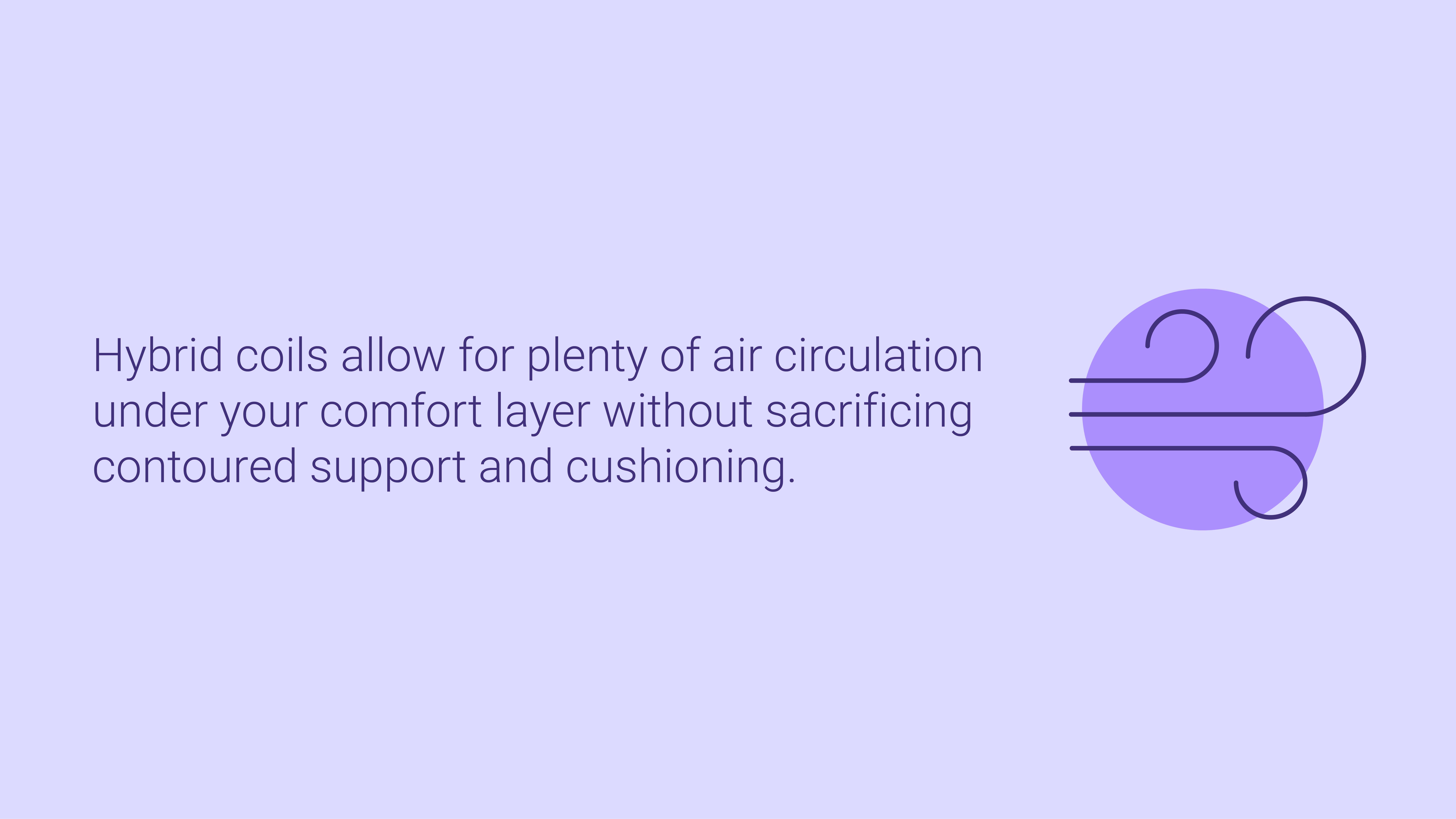
Not all hybrids feature a transition layer, but many do. This layer is typically made of poly-foam or firmer latex or memory foam.
Transition layers are meant to add cushioning and bounce underneath the foam to protect the sleeper from potential pressure from the coil support core. Some transition layers feature zoned technology to improve body weight distribution and offer targeted support to the different areas of the body.
Support Layer
Hybrids always have a pocketed coil support layer. That means, rather than featuring a support layer of interconnected coils like innerspring mattresses often have, each of a hybrid’s coils is wrapped in its own individual sleeve or “pocket” and free to move independently of the other coils in the core. This sets pocket springs apart from open coils, which are used in traditional innerspring mattresses.
The sleeves surrounding the coils can be made of foam or fabric, and they work to reduce the motion transfer and squeakiness associated with traditional spring support cores without sacrificing airflow. The pockets also mean hybrid support cores are more adaptable than networked coil systems because they can compress and rise to fit your unique shape.
The main reasons hybrids feature a coil support layer are to increase the responsiveness and air circulation of the bed. The two main complaints about traditional memory foam mattresses are they retain heat and have no bounce. A hybrid’s coil support core solves these problems, and it even gives extra bounce and circulation to the naturally cooler and more responsive latex.
Base Layer
Some, but not all, hybrids have a base layer of hard foam underneath the coil support layer. This foam base layer helps protect the bottom of the coils from wear and tear, making the mattress more durable by helping the coils keep their tension longer.
The base layer can also help reduce motion transfer and noise even further by cushioning the coils as you move around on the bed.
Hybrid Comfort Layer Materials
There are several types of foam that a hybrid can feature in its comfort layer, but the most common ones are latex foam and memory foam, while they’re tailed by the up-and-comer Serene™ foam.
Latex Foam
Latex foam contours similar to memory foam. However, since latex foam is made of the sap of the rubber tree, it tends to have more bounce than memory foam. This sap is harvested, processed, and turned into a springy, plant-based foam with incomparable cooling ability. Latex foam has many benefits. For example, organic latex is one of the most eco-friendly, non-toxic materials you can purchase. It contains almost no chemical additives or processing ingredients.
Latex is resistant to dust, dust mites, pollen, and other allergens, so it’s great for sensitive sleepers (as long as they don’t have a latex allergy).
There are two types of natural latex: Dunlop and Talalay. Both of these types come from the exact same sap. The difference is not in the type of raw sap, but how that sap is processed.
Dunlop Latex
Dunlop latex is the more energy-efficient of the two latex types. In the Dunlop method, the liquid sap is whipped into a foam and poured into a mold. That mold is immediately zapped inside a vulcanization oven. Then, the baked foam is washed to remove impurities, dried, and prepped for shipping. Dunlop is denser and less bouncy than Talalay latex, and it’s also a bit cheaper.
Talalay Latex
The Talalay process is a little more energy and labor-intensive. Like with Dunlop, the raw latex is whipped into a foam and poured into a mold. Unlike Dunlop, Talalay latex is only poured halfway up the mold. Then the mold is sealed and the latex allowed to proof like bread before being flash-frozen to push C02 bubbles into the latex.
The process then goes back to resembling Dunlop. The frozen Talalay latex is vulcanized, washed, dried, and prepped for cutting, shipping, etc. This makes for a lower-density, bouncier, and slightly more expensive latex.
Despite their differences, Talalay and Dunlop latex don’t feel all that distinct, and you will likely be happy with a hybrid containing either one.
Synthetic Latex
There is a third type of latex made of petroleum products. It’s called SBR or Styrene-Butadiene Rubber. This material is often used to make things like yoga mats, tires, and shoe soles, but it’s also used to make some mattresses.
Mattresses made of or containing SBR are typically low-quality and unsupportive. They also often have a foul odor because they have higher levels of volatile organic compounds (VOCs): toxic chemicals used in the manufacturing process.
While almost nothing sold to be sat or lain on ever has high enough levels of VOCs to pose an immediate threat to your health, the smell of these chemicals can cause mild symptoms like nausea and headache. The unpleasant odor plus the lack of support of SBR mean this substance is better left in yoga mats than in the comfort layer of your hybrid mattress.
Memory Foam
Like latex, memory foam makes a great hybrid comfort layer. Though it’s not as cooling or bouncy as latex foam, the special type of polyurethane foam is more flexible, giving it the ability to mold itself to your shape, compressing under your pressure points and rising to meet the areas that need extra support.
Originally designed by NASA back in the 1970s as a method to improve aerospace crash protection and seat cushioning, memory foam quickly became one of the most popular bedding materials because of its ability to both cradle and support.
Our memory foam mattress buying guide has plenty of information about the type, but we detail some of the common variations below.
Open-Cell Memory Foam
One of the biggest complaints about memory foam is its tendency to retain heat. However, since the turn of the century, advancements in sleep technology have improved memory foam’s temperature-regulating abilities.
One such improvement is open-cell technology. Open-cell simply means the memory foam has thousands of tiny pockets throughout the foam to allow air circulation. This type of memory foam is much better at wicking away body heat than closed-cell foam, which is why it has become quite ubiquitous. Nowadays, pretty much all memory foam is open-cell.
Gel Memory Foam
Gel memory foam and standard memory foam are similar. However, gel memory foam is infused with cooling gel. A newer development in cooling technology, gel helps keep you cool by diffusing body heat and distributing it away from you. Gel can be added to liquid memory foam in a number of ways. Manufacturers might swirl gel into the foam or infuse it with microbeads made of gel. Some memory foam hybrids also come with a layer of gel on top.
If you’re a hot sleeper, the combination of a gel memory foam comfort layer with a hybrid’s pocketed coil support layer will help keep you cool all night long.
Serene™ Foam
The latest in sleep technology, Serene™ foam is a type of high-performance polyurethane foam that incorporates billions of microscopic air capsules to increase breathability without sacrificing support. The air capsules all take in and release air independently of one another acting as shock absorbers to cradle pressure points as well as diffuse heat.
While it is possible to get a Serene™ foam hybrid, this foam type is so new that there aren’t a lot of options available. Furthermore, since it’s only a few years old, we don’t know a lot about its durability over time. You’ll want to take that into consideration when you shop for a Serene™ foam hybrid.
Hybrid Support Layer Coil System
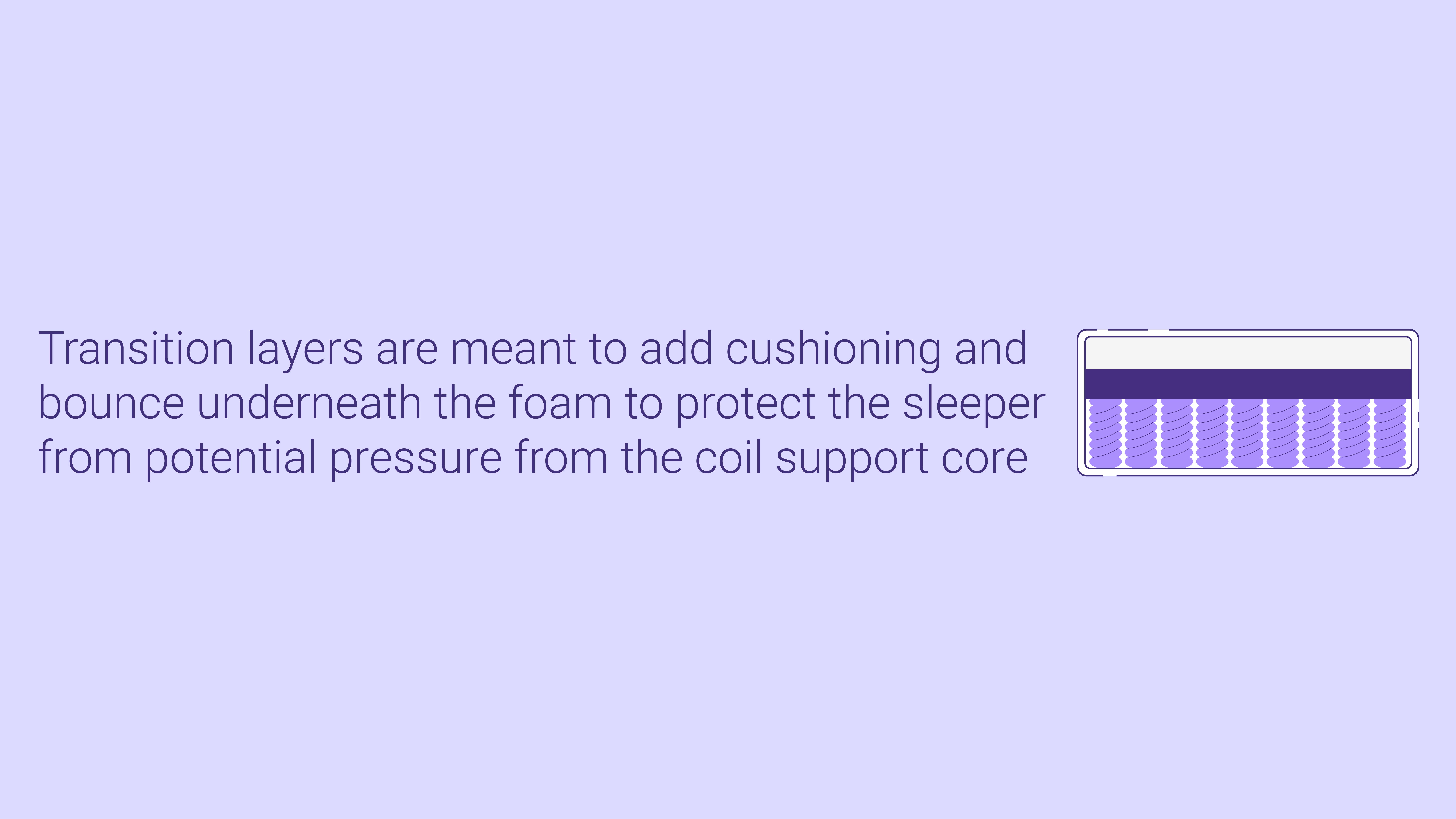
Coil Count
The coil support layer has another job besides supporting the sleeper. It also must help the mattress maintain its shape. This means it needs to have enough coils to get the job done. A high coil count indicates a quality mattress that will offer great support and maintain its shape longer.
However, watch out for overly high counts. While low counts indicate a cheaply made mattress that is unlikely to last a long time, high counts are just a marketing gimmick and an excuse for mattress retailers to overcharge. The ideal coil count ranges between 800 to 2000, depending on the size of the hybrid.
Coil Gauge
Coil gauge is simply coil thickness, and it’s measured in millimeters. The higher the gauge, the thinner the coil. The thinnest coils are around 18 mm, while the thickest are 12. Lower-gauge coils offer stronger support and higher durability. Mattresses with higher-gauge coils may sag prematurely.
Edge Support
The coil support core doesn’t just keep the mattress’s middle from sagging. It also has to support the mattress’s edges to keep them as high as the center. Hybrid mattresses are famous for their edge support. A lot of hybrids either increase their coil count around the perimeter of the mattress or use firmer coils around the sides to achieve ideal edge support.
Hybrid Firmness Levels
One of the best things about hybrids is their diversity of feels and firmnesses. Hybrids not only offer different foam options for their comfort layers, but they also come in the full range of firmness levels. The firmness you pick will depend largely on your sleep position and body type.
The mattress firmness scale runs from 1 to 10, with 1 being the softest. Normally, it’s not easy to find a mattress softer than about a 3 or harder than an 8. There’s no market for mattresses with zero support or zero softness, so manufacturers don’t make them.
As a general rule, side sleepers need the softest support while stomach sleepers need the firmest. While your sleep position is the number-one factor in your choice of firmness, body type can play a role. Lightweight sleepers typically need softer support while heavier sleepers need firmer.
Soft
Soft hybrid mattresses are around a 3 on the firmness scale. The feel of this mattress is very plush. It should compress easily and offer tons of cushion. Soft mattresses feel almost like sleeping on a cloud.
While soft mattresses are pleasantly squishy, they’re not for everyone. Stomach sleepers and heavier sleepers (over 230 pounds) would do best to avoid this firmness level. The best hybrids for side sleepers and petite sleepers (under 130 pounds) are soft to medium because they offer more cushion than firmness, easing pressure in the joints and compressing enough for lighter people.
Medium-Soft
The next step up is the medium soft mattress (4). A hybrid of this firmness level will still have plenty of give and cushion, but it will offer a little more resistance than a soft mattress.
Medium-soft hybrids are also good for petite and side sleepers who like a little extra firmness, but they offer enough support to average-sized sleepers and even some heavier side sleepers who find firmer mattresses uncomfortable.
Medium
Medium hybrids fall right in the middle of the firmness scale at a 5. While they still offer a lot of compression, you’ll also feel a good bit of resistance as well. Medium hybrids offer versatile support and are great for a wide variety of sleep positions and body types, but they make the best mattresses for combo sleepers.
Medium mattresses are one of the best beds for couples because their combination of plushness and support is versatile enough to accommodate the widest range of sleepers.
Medium-Firm
When you get to medium-firm (6), you start to trade off compression for support. Medium-firm mattresses should still have a good amount of cushion, but they’ll push back against the pressure of your body weight to keep you lifted.
Medium-firm hybrids make the best mattresses for back-sleepers and heavier sleepers. The best mattresses for back pain are also medium-firm because they are firm enough to keep the lumbar spine supported and the spine neutral.
Firm
With firm hybrids (7), you’ll feel a lot of resistance and little cushion. Firm mattresses should still have enough cushion that it doesn’t feel like you’re sleeping on a wooden slab, but they should also offer tons of support.
Firm mattresses are best for plus-size sleepers and stomach sleepers. In fact, all but the most petite stomach sleepers should consider a firm mattress because it will keep the pelvis lifted onto the bed, preventing lower back pain.
Hybrid Bases
Hybrid mattresses are heavy, so you can’t just put them on any old bed base. The best bases for a hybrid mattress are a mattress foundation, platform bed, or an adjustable base.
Mattress Foundation
Mattress foundations are metal or wooden frames with slats laid across them at regular intervals. Foundations aren’t made to stand on their own. You’ll need to set them on a bed frame before laying your hybrid on one.
The ideal gap between slats is between 2 and 3 inches to leave enough room for air circulation while still offering sturdy support, but slat gaps can range from 1 to 5 inches. If your foundation’s slats are more than 3 inches apart, you’ll need to add slats or a bunkie board to accommodate a hybrid mattress.
Platform Bed
Platform beds are just like hybrids in the sense that they’re frames with slats stretched across them. However, unlike mattress foundations, platform beds are made to stand on their own. Some platform beds are just simple frames with legs. But other platform beds have headboards, footboards, storage space, and even canopies.
Like with mattress foundations, you should only lay a hybrid on a platform bed if its slats are less than 3 inches apart or you have a bunkie board under the mattress. Another thing to watch with platform beds is their low profile. A bed frame/mattress foundation combo will come up to around 24 inches, but platform beds’ profiles are lower—around 16 to 18 inches.
If you’re young and able-bodied, this height won’t be an issue. However, if you have limited mobility, this low profile could cause problems, and you might be better off with a higher bed.
Adjustable Bases
Some people think hybrids aren’t good for an adjustable base because of their spring support core. However, unlike a lot of traditional innerspring mattresses, hybrids’ pocketed coil support system is quite flexible, and it can bend and flex with the adjustable bed no matter what position it’s in.
Adjustable beds are great for people who experience back pain, joint pain, sleep apnea, acid reflux, and a host of other problems because they allow you to sleep in an elevated position.
Box Springs
Box springs are never a good base for hybrid mattresses. Their spring network is too weak to support the weight of heavy hybrids and will over-compress and maybe even break under this and other heavy mattress types. Furthermore, a lot of hybrid mattress manufacturers specify that using box springs with their product will void its warranty.
How Much Should I Pay for a Hybrid?
Hybrid prices can range widely, but they’re generally the most expensive type of mattress because it’s more costly to manufacture and compile all their components. The average queen sized hybrid is between $1,000 and $1,300.
Budget hybrids can cost as little as $300, but at this price, you need to be aware of quality. A mattress this affordable might not be very supportive or comfortable. Hybrids this cheap may also be made of lower-quality materials that won’t last very long, meaning you could be replacing your mattress more often.
Meanwhile, hybrids on the higher end of the price range (over $3000) may have a lot of luxury features and additional sleep technologies. These are great for those who can afford them, but they’re not necessary for a good night’s sleep. If you pay between $600 and $2,500 for a hybrid mattress, you can be reasonably sure you’ve gotten a quality bed at a fair price.
Saving on a Hybrid Mattress
Want to maximize your savings on a new hybrid mattress. We suggest keeping an eye out for the year’s recurring best mattress sales for added discounts and mattress bundles.
- Best Presidents Day Mattress Sales
- Best Memorial Day Mattress Sales
- Best 4th of July Mattress Sales
- Best Labor Day Mattress Sales
- Best Black Friday Mattress Sales
- Best Cyber Monday Mattress Sales
Who Should Sleep on a Hybrid?
The short answer to that question is almost anyone should sleep on a hybrid! They’re comfortable for all sleep positions and come in the full range of firmness levels, meaning you’re almost guaranteed to find the one that’s right for you. However, there are a few people who might get the most out of them.
Plus Size Sleepers
If you’re over 230 pounds, you need extra support to achieve optimal spinal alignment. Pocketed coils offer such support. They’re strong and sturdy, and they’ll give you the lift you need to keep you on top of the bed instead of letting you sink into it. Mattresses made entirely of foam might let you sink too much and leave you feeling stuck.
Back Pain Sufferers
Those who have back pain—especially low back pain—may also enjoy the extra support of a hybrid mattress. Because the pocketed coils are adaptable just like the foam comfort layer, they work with the latex or memory foam to contour to your shape, keeping your spine aligned and your body lifted onto the bed.
Hot Sleepers
If you wake up sweating at night but don’t like the pressure or extreme bounce of an innerspring, then you’ll likely enjoy a hybrid. Hybrid coils allow for plenty of air circulation under your comfort layer without sacrificing contoured support and cushioning.
Some hybrids also come with cooling technologies like cutouts, microbeads, or gel, making them even cooler.
Couples
Hybrid mattresses are great at isolating motion, making them ideal for couples who worry about disturbing one another in bed. Hybrids’ extra air circulation can also help offset the extra heat from two sleepers. And their sturdy coil support system helps maintain lift in the middle of the mattress, even under two sleepers’ additional weight.
Pros and Cons of a Hybrid Mattress
Hybrids are so comfortable and pleasant to sleep on they’re just about all-pro, but they do have a couple of drawbacks you need to be aware of. Let’s see how they stack up against all-foam and innerspring mattresses.
Pros
Hybrids are much more responsive than latex foam and memory foam mattresses. The coils under a hybrid’s comfort layer add bounce to the foam that it could never match on its own. At the same time, hybrids are much better at isolating motion than traditional innersprings. Their pocketed coils and/or foam base layer reduce motion transfer better than networked coils.
Hybrids are also a lot more supportive than innersprings. Not only are hybrids’ comfort layers a lot thicker and more contouring, but hybrids’ pocketed coil support cores are much more adaptable than innerspring support layers. All this means hybrids can offer more customized support to your unique shape.
Hybrids might not be quite as cooling as innersprings, but they blow foam mattresses away with their increased airflow. The pocketed coil system allows air to circulate freely, helping to draw your body heat away from you.
Hybrids also offer pressure relief that’s comparable to what you would get with a memory foam or latex mattress. Their thick, plush top layer combined with the transition layer eliminates just about all pressure from the coils and cradles your shoulders and hips to relieve/prevent pain.
Cons
One of the biggest issues with hybrids is they’re heavy. Not only does this mean you can’t set them on the box springs you already own, but it also means hybrids aren’t the easiest mattresses to move. This is something to think about if you relocate a lot.
Hybrids are also expensive. We talked above about how they’re more costly to manufacture because of all their components, and that expense gets passed right down to the customer. You can expect to pay anywhere from a few hundred to over a thousand dollars more for a hybrid than you would other types of mattresses.
Hybrids also are not as durable as straight foam mattresses. While they will outlast just about every innerspring mattress, hybrids still have a coil support layer. These coils eventually lose their tension and break down, causing the mattress to lose its shape. This process will take a long time (10 to 15 years), but hybrids still don’t have the same staying power as memory foam and especially latex.
FAQs
How thick should a hybrid be?
Mattress thickness will depend on the number of layers in the bed. Quality hybrids have multiple layers, all of which are at least a couple of inches thick. In addition to the 2-inch or more comfort layer, the transition layer will likely be a couple of inches. The pocketed coil layer is typically around 6 inches thick, while the base layer is around an inch.
All that means your hybrid should be at least 10 inches thick. A high-quality hybrid should also have a coil support layer that constitutes at least half its total thickness (i.e. if the mattress is 12 inches thick, then the coils should be 6 inches or more).
What’s the difference between hybrids and pillow top innersprings?
Hybrids and innerspring beds both have coil bases. However, the comfort layer on these two matress types is very different. While a hybrid has a pocketed coil support layer and a foam comfort layer, innersprings can have a lot more variety in their construction. Innersprings might have one of several different types of networked coil construction, like Bonnell, offset, or continuous coil. Innersprings also have a very thin comfort layer often made of wool, cotton, or other fibers.
Pillow tops are also not the same thing as comfort layers. Pillow tops always sit on top of the comfort layer to add extra padding. A few hybrids come with this setup, although a pillow top may be redundant because their comfort layer is so thick.
However, since innerspring mattresses are topped with a much thinner comfort layer, it’s a lot more common to see them with a pillow top.
Can I flip my hybrid?
In a word: no. Hybrids aren’t like innersprings and some foam mattresses where either side is the right side up. Their construction only allows for one top and one bottom. Flipping a hybrid mattress on its comfort layer can damage the coil support system and the foam top layer as well. Plus, laying on the base layer or the bottom of the coil system wouldn’t be too comfortable.
Some hybrids are designed to be flippable, meaning they have a comfort layer and maybe a transition layer on both sides. A few hybrids even allow you to switch firmness levels by having one soft side and one firm side. However, hybrids constructed in this manner will say so clearly on the label.
How often should I rotate my hybrid?
You should rotate most mattresses, including hybrids, once every six months. To rotate, just take the side of the mattress at the head of the bed and turn it to the foot. This keeps your mattress from aging unevenly or developing soft spots.
What kind of certifications should I look for in my hybrid?
That depends on the kind of hybrid you get, as there are a lot of different certificates mattress manufacturers can apply for.
Hybrids with memory foam may come with a CertiPUR-US certification to indicate the memory foam is low in toxic chemicals. Meanwhile, if you get an organic latex hybrid, look for a GOLS (Global Organic Latex Standard) certification to indicate pure organic latex.
Mattresses that use other textiles like cotton or wool fibers in their cover or components can apply for a GOTS (Global Organic Textile Standard) certification to indicate their status as organic, non-toxic, and sustainable.
A GreenGuard Gold certification indicates the hybrid has low VOC emissions. While an OEKO-TEX Standard 100 certification indicates the whole mattress is free of toxic chemicals, whereas a CertiPUR-US, GOLS, or GOTS certification would only apply to the relevant textile and foam components of the mattress.
Bottom Line
Hybrids are one of the best ways to get a great night’s sleep. They combine the best attributes of memory foam and/or latex with the best attributes of an innerspring mattress to deliver a truly cushioning, supportive, and comfortable sleep experience no matter your preferences.
